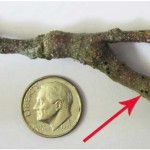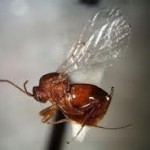Early Spring 2012, Oak trees all along the coastal areas of Falmouth, Yarmouthport and Brewster began showing very serious signs of die-back and stress. It was not very clear at first what

This is typical of the damage caused by the Crypt Gall Wasp.
was going on with these distressed trees. Perhaps these trees were suffering from the salty blasts of wind they received from Hurricane Irene the previous year. After all, it didn’t rain again after that storm for quite a few weeks. And then we had such a mild winter here on Cape Cod. Or maybe the successive years of defoliation from the Winter Moth “plague” we’ve been experiencing here have taken their toll on these trees. Many theories as to why these trees all seemed to be suffering so suddenly and so drastically, but it wasn’t until Robert Childs, Plant, Soil and Insect Sciences with the UMass Amherst Landscape, Nursery and Urban Forestry Program, announced the discovery of a very small insect that the answer became clear.
Cynipid Gall Wasp otherwise known as the Crypt Gall Wasp (Bassettia ceropteroides) was confirmed to be the culprit of all of this Oak die back. The chief symptoms of infection are the clearly visible lack of leaves, early flagging (or leaves losing green color), and swollen twigs. Closer examination of the swollen twigs reveal small exit hole created by the adult wasps emerging. The loss of foliage can be up to 90% in some trees.
There are over 700 species of gall wasps in North America that form galls on Oak, but none seem to be so destructive as this new comer to Cape Cod. Very little is known about the habits and life cycle of this small pest. It is thought that female wasps lay eggs in early spring before foliage is completely unfolded, and the eggs hatch out larvae that feed into the twig as the tree grows. This feeding forms an enclosed chamber within the twig and the saliva of the larva actually produces a genetic mutation in the tree. This is how the swollen gall is formed. The larvae go on to feed on nutrients within this enclosed chamber. The larvae mature into an adult
female wasp, which then chews thru the twig to emerge on the surface. The damage that the larva inflicts on the vascular system of the trees twigs is what cuases the loss of leaves and weakened canopy. Read full fact sheet about Bassettia ceropteroides here.
- Swollen twig with small exit holes
- Tiny Adult Wasp
Trees that have experienced previous stress seem more likely to suffer die-back from the Gall Wasp. Therefor steps should be taken to increase the health of susceptible Oak trees, particularly, along the coastline. Avoid drought stress and defoliation from Winter Moth feeding. Also improving soil fertility may help to alleviate stress on affected or susceptible trees. There are treatment strategies that may help to protect your trees from infestation, but as we are still learning about the life cycle of this insect, specific controls are still being developed.
Contact Forest Keepers to help manage the health of your shade trees this coming season as this outbreak continues to develop. We will keep you updated as more is learned about this destructive pest.



Comments
Will Oaks die completely or will they REcover FROM crypt gall wasp
Well, there is still much to learn about this pest and it’s impact to the Oak trees.
We have seen some Oak’s That are about 90% defoliated and it seems that those trees will not make it.
Many other Oak trees that we have been treating seem to be doing relatively well and will likely recover.
We strongly advise putting any trees weakened by this pest on a annual fertilizing program to help them recover lost resources.
Our oak trees are being impacted. Please recommend fertilizer and amount ….. we live on a saltwater river…..
Many big old beautiful Oak trees being killed in North Falmouth near our house, sad situation.
First the winter moth attack them, then these horrid little Crypt Gall wasps.
Some manage to survive, but many dont. The ones which die and have to be removed gets to be an expensive ordeal.
Yes, fertilizer and watering helps, but the big old trees are not doing well here on our street.
Jane
I am seeing this in St. Peters Missouri which is about 30 west of St. Louis. Has there been any updates as for treatment? Thank you, Darrell
I will have one of our Arborists get in touch with you.
Could you inspect and treat our apple tree that seems to be in very bad shape. We do not know what is happening to it other than it is sick or diseased. Also, an inspection of our other trees would be a good idea.
We are in Yarmouth port, Ma.
Thank You
Send us a request through our free estimate link and we will gladly come out to take a look at your trees.
Thanks
Is it only oaks that are affected? I live on the Cape and have noticed many different types of trees, including cherry, pear, red bud “forest pansy” and oak on my own property that seem stressed. By that I mean they have more and more dead branches each season and are covered in lichen. From what I read, lichen tends to grow more prevalently on stressed trees. Could it be because of the wasp?